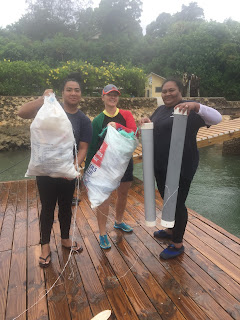The turtles for Tonga, nest between the months of December through March, often the females have migrated from Samoa or Fiji to return to the nesting beaches here to lay their eggs, these nesting beaches are the same for the female turtle as where they were born, so the health of these islands is of major importance to the survival of turtles. This includes the management of invasive species such as rats as well as reducing the amount of rubbish and waste that is left or drifts upon these fragile habitats.
 |
| A turtle nest (pit) |
Six turtle nests were identified and tagged during the surveys today, sadly many of the tracks had been washed away with the extreme high tides and swells we have had recently.
There has been a lot of sand shift on our outer islands which results in large areas of exposed sandstone, making it harder for the turtles to access the sand areas for nesting as shown in the picture above!
Not only are the outer islands important for sea turtle nesting, but also for sea bird nesting and today we were treated to a variety of chicks. A new one for us today was the very young chicks of the Black Naped Tern (Sterna sp.), a ground laying bird that builds small rock nests upon the beach or lay their eggs in the shrubs just above the high tide mark. As they are ground nesters, these chicks and eggs are extremely susceptible to predators and damage from picnic parties that do not know they are there.
 |
| A Black Naped Tern chick being protected by the coral rubble and rock nest. |
 |
| The eggs of a Black Naped Tern laying along the shoreline above the high tide mark. |
Other chicks spotted were the resident noddy, however only a few chicks
were spotted in comparison to other years. Whenever, you conduct outer
island surveys on bird nesting islands, you have to be not only careful
where you put your feet, but also not to disturb the chicks that are on
the low shrubland along the coast.
 |
| A noddy chick sits just off the ground in the low shrubs on the outer islands. |
Sadly though, the islands were also blighted with plastic waste, diapers, glass bottles and some PVC tubes that we believe may have been used as a float.
 |
| Two of these PVC tubes were collected on seperate beaches |
Thanks to the hard work of our team today - Lisa, Seini and Kelli, the islands were left much cleaner than when we got there.



No comments:
Post a Comment